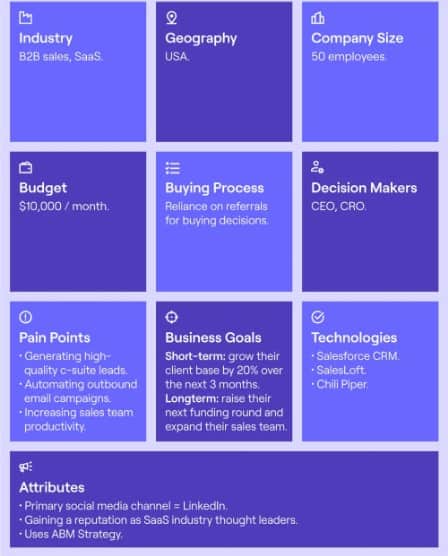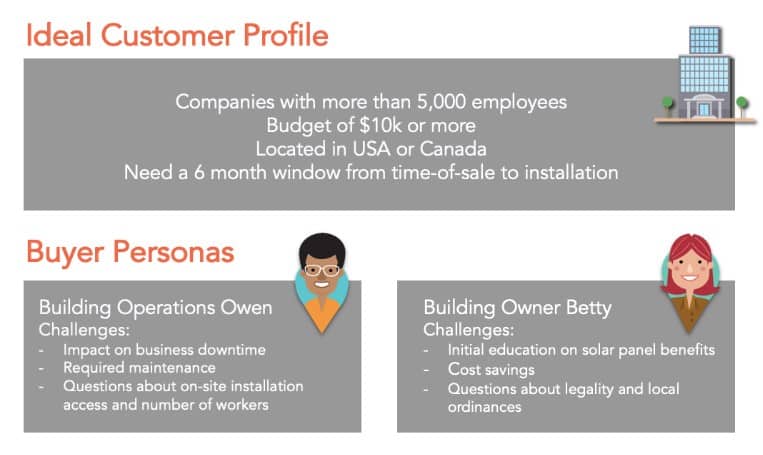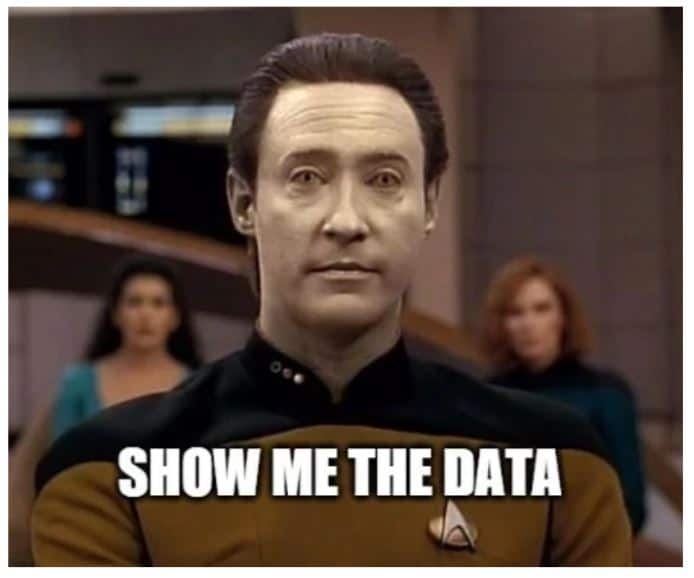Creating an ideal customer profile (ICP) for your marketing and sales process is important. Picture yourself as an expert chef making two separate menus: one for an athlete watching their calorie intake and another for a foodie looking to indulge. Nothing would be the same—not the ingredients, presentation, or flavors.
Why? Because you need to cater to each customer according to their tastes and requirements.
Akin to this culinary skill, businesses must cater their marketing and sales to their customers’ interests. Real success comes from zeroing in on your target market and creating products and services that speak directly to them.
An ICP depicts your ideal client and includes all the details about them, including their:
- Demographics
- Behaviors
- Problem areas
- Goals
It lets you find the people who will be the best customers for your products and services.
In this detailed guide, we teach you all you need to know to create an ideal customer profile (ICP) for your business. We cover:
- A detailed explanation of what ICP is and why you need it
- A step-by-step blueprint for creating ICP for your business
- The difference between ICP and buyer personas
- Common mistakes to avoid with your ICP
- How to use your ICP to reach more leads and increase sales
Keep reading until the end because understanding your customers isn’t just an advantage—it’s necessary for sustained growth in business.
Table of Contents
Understanding an Ideal Customer Profile in Marketing and Sales
The ideal customer profile (ICP) describes the perfect customer a business targets in its marketing and sales efforts. It thoroughly portrays the customer, be it other companies or individuals, that are:
- Most likely to buy from you
- Gain the most from your product or service
- Will stick to your business in the long term
- Likely to refer your business to others
Ideal customer profiles are critical to business strategy for early-stage and established businesses. It ensures you direct marketing and sales efforts toward the most promising prospects. They allow sales and marketing teams to:
- Precisely identify ideal clients
- Target their lead-capturing efforts toward them
- Complete agreements to convert leads into paying customers
Foundations of Building an Accurate Ideal Customer Profile
Data will be critical in developing your ideal customer profile. However, low-quality data leads to chasing low-quality leads. And spending money on nurturing leads that won’t convert results in losing resources.
Therefore, before we jump into a step-by-step process of creating an ICP, take care of these three tasks to set yourself up with data:
- Conduct market research: Find out what makes up the customer base of your competitors. Find common patterns among these customers. You might be able to put your finger on the following:
- What makes satisfied customers happy?
- Why unsatisfied customers aren’t happy with what the market already has?
- Identifying key characteristics of your ideal customer: Determine the firmographic and behavioral characteristics of customers your product or service caters to. This can be —
- For businesses:
- Company size
- Industry
- Challenges
- Business goals
- Individual customers:
- Age
- Occupation
- Gender
- Interests
- Buying habits
- Utilize existing customer data: You may learn a lot about your ideal clients by observing the people interacting with your company. To further understand these people and collect customer demographics and psychographic data, you might look at the following:
- Customer relationship management (CRM) software
- Loyalty programs (if you offer any)
- Their purchase history
Using relevant data to create reliable ICPs lets you focus marketing efforts on the right leads. It’ll help you:
-
- Deliver the right message
- Focus on their needs
- Convert them to exceed your sales goals
Example: iRidi
iRidi, a smart home and building automation platform, did just that. They acquired 34 new sales opportunities at a modest $3,000 ABM budget with hyper-focused audience targeting using ICPs.
Read also: Master Customer Data: A Guide For Customer Insights
Step-by-Step Guide to Creating an ICP
Once you’ve taken care of the foundations mentioned above, you’re ready to create an ideal customer profile for your company. To make it easy for you, we’ve divided the process into just four steps.
Step 1: Get data on your current customers
When you create an ideal customer profile (ICP), you want it to reflect your best customer. A “best customer” could mean different things to different companies. However, it starts from the database of your current customers.
Make a list of your top clients. This list should reflect the kind of businesses and individuals you want to attract in the future.
Here are some tips on where and what kind of customer data you’ll collect if you are looking for ICP:
Where to find the right data?
The most reliable information comes from credible sources that support it with evidence. These sources include but are not limited to the following:
- Information gathered from front-line employees, salespeople in the field, and other influential decision-makers like marketing and sales managers
- Records of customer service and information gathered from your CRM system
- Relevant industry reports with benchmarks
Your data should come from your most satisfied customers. You want to scour through the following:
- Deals that made you profit
- Long-term customer accounts
- Returning customer accounts
- Customers who refer you to others
- Customers you managed to upsell or cross-sell
- Customer satisfaction surveys for happy customers
What to look for in the data
- Average money they spend on your product/service
- Length of time as a client
- The common membership tier they opt for
Step 2: Analyze data and determine the characteristics of your best customers
You have data on your best customers. The next step is to analyze the data and define the following:
- Why are they the best customer?
- What contributes to their satisfaction?
- How did they come across your product?
- What are the shared characteristics of your best customers?
Answering these questions helps in understanding your ideal consumers better, including their:
- Purchase motivations
- Pain points
- Use cases (of your product)
With this data at your disposal, you should be able to spot prospective clients with comparable qualities in the future.
So, how do you do that?
- Interview your best customers: Get to know your consumers personally, over the phone, or via video chat to discover the answers to the above questions.
- Use your support team input: Go through the call record of the customer support team and support tickets.
- Collect feedback with online survey tools (such as Google Forms): Almost 90% of businesses rely on customer survey responses to understand their product better.
- You may also: Use web analytics and social media data to identify prospective consumers with customer demographics matching your current best customers and then analyze these indirect findings.
To ease your marketing efforts in the future, we suggest you segment your customers based on their shared characteristics using a CRM software solution like EngageBay. This will help:
- Create an ideal customer profile template
- Hyper-target marketing efforts toward leads that fit into your ICP
Read also: 10 Amazing Ideal Customer Profile Templates for all Industries
Step 3: Drafting the Profile
Once you’ve got the right data, analyzed it, and segmented your customers, you may consolidate data into a coherent profile. You have to include essential details regarding a perfect consumer, such as:
- Business characteristics (size, sector, location, etc.)
- Individual characteristics (age, gender, role, etc.)
- Behavior insights (pain points and variables influencing purchasing decisions)
When creating your ideal customer profile (ICP), you must include your unique selling points (USP). This section defines why a customer will pick you over your competitors.
Your marketing and sales teams may use the USP section in your ICP to guide your sales and marketing teams as follows.
- Sales team: Pitch products and service benefits tailored to individual profiles.
- Marketing team: Deliver targeted messages by focusing on the unique selling point.
You can create an ideal customer profile (ICP) with a spreadsheet or table. However, make sure not to complicate it in a text-heavy format. Here’s a simple example:

Step 4: Test, validate, and refine
Once you create an ideal customer profile (ICP) for your company, it’s important to refine it with changing customer behavior. Review your ICP every three months and add any new data that surfaces from your new customer base. Consider doing the following:
- Take note of comments and reviews: G2 is a great place for tech startups and SaaS marketers to find client reviews.
- Check your website’s traffic statistics: Determine which pages get the most views. It may show what your target audience is looking for right now. Learn more about your site’s traffic source and the kind of people that are visiting your site. You may improve your marketing channel selections with information like this.
- Learn from your revenue generation data: Determine which customers have the highest lifetime value. Who are the most profitable customers? You may enhance your ICP by looking for patterns in your numbers.
- Look for trends in new customers: Is there a specific source that brings you new customers? How are they finding their way into your sales funnel? When making a sale, is there anything you do to increase your odds of success?
- Use lead scoring tools: Lead scoring may leverage your top customers’ important behaviors and high-impact qualities to produce ratings. It simplifies your sales process and guarantees you always contact the most potential prospects.
- With an all-in-one CRM tool like EngageBay, you can get a 360-degree view of your most profitable clients. You can dive deep into the traits and behaviors they most frequently exhibit to focus on the most promising customers.
Read also: The Customer-Centric Model: Your Definitive Guide for 2024
What’s The Difference Between Ideal Customer Profile and Buyer Persona?
ICP and buyer personas work together to allow businesses to get insightful data to guide their sales and marketing efforts. They are resources to let companies develop engaging and personalized content, experiences, and marketing campaigns.
While an ICP paints a broad picture of the ideal clientele for the company as a whole, buyer personas drill down into specifics by analyzing different types of customers within that profile. I’ve outlined the key differences between a buyer persona and an ICP in the following table.
| ICP | Buyer Persona | |
| Definition | Framework for strategic planning that helps a company determine who its ideal client is. | A fictionalized portrayal of an individual customer made using ICP traits. |
| Elements included | Consider several segments to construct a comprehensive profile of the intended audience to identify their target demographics. | Deeply explores a single consumer segment of ICP by focusing on a fictitious representative’s characteristics, tastes, and actions. |
| Scope | Provides a bird’s-eye perspective of different types of best customers by highlighting similarities and growing trends. | Explore a group of consumers with individual profiles, including more than just demographics, to reveal each persona’s distinct traits, goals, and obstacles. |
| Use | Directs and aligns marketing and sales activities with the target demographic.
Better target certain demographics by adjusting their messaging, positioning, and platforms. Zero in on the clients who will bring in the most money and devote their resources to them. |
Vital in developing hyper-personalized marketing and sales strategies.
Create content and ads that speak to an individual’s unique requirements and preferences. Enhance engagement, conversion rates, and client relationships. |

Read also: A Guide To Enhancing Customer Data Management
How Do You Use an Ideal Customer Profile in Marketing and Sales?
If you have a solid, data-backed, ideal customer profile,
- Your marketing team can generate leads more efficiently
- Your sales development reps (SDRs) can convert customers more easily
You can use account-based marketing (ABM) to zero in on specific, high-value accounts and prospects, which lets you:
- Make high-quality MDR and SDR target lists with leads with higher conversion potential
- Tailor sales pitches and content marketing efforts for each customer segment with a personalized, high-quality message at every stage of the sales process
- Get insights to target prospective customers at the most advantageous times
- Address pain points at different stages of customer lifetime to maximize customer lifetime value (CLV)
Your ICP will define customer needs and pain points. Your business can then do the following to win more customers:
- Set a strategic price
- Match the quality to the price
- Market the options for different audience segments
- Offer access to your product or service the way they prefer
Let’s take Starbucks as an example. The company prices its products 38% higher than its competitors. Yet, with a deep understanding of its ideal customer, Starbucks meets customer expectations through quality, branding, and experience.
Avoid These Common Mistakes When You Create Your Ideal Customer Profile (ICP)
To target the right people, businesses need to specify clearly the ICP parameters we discussed above. The information you use to predict who would buy your product or use your service comes from studying your most valuable consumers and those of your competitors. However, many companies lack research, and their ICP profile is too broad. They aren’t unsure about their direction.
Finding the correct ICP might be challenging for new businesses without any client data to work with. Common mistakes they make, as mentioned below, may reduce the efficiency of ICP.
Ignoring current customer insights
Not leveraging existing customer data leads to an unrealistic ICP. Your ICP needs to mirror the kinds of businesses that benefit from and use your offerings. And you can only find this information from your own client base, no matter how small it is.
Solution: Review your existing clients by finding the “best” customers that your sales staff has closed. This data can be a few clicks away if you have a robust CRM. If not, you may use the data collection methods mentioned in step 1.
Assuming data insufficiency
It is difficult for many new businesses to have enough consumer data. Fairly established companies may also have difficulties maintaining a big database. However, data is always available somewhere, and believing you lack enough information can delay ICP creation.
Solution: Start with available data and continuously update your ICP. For example, de-anonymizing your site’s traffic is a good first step in creating an ideal customer profile for your users. If your target market is big enough, you can narrow down the qualities of an ICP for your company. Next, you may confirm whether your initial assumptions are correct by reevaluating your ICP as you close additional clients.
Overreliance on firmographic data
Relying solely on basic firmographic data limits ICP depth. It is important to determine the issue you’ll be addressing for your target accounts and what motivates them to make the purchase.
Solution: Using the firmographic data as a jumping-off point, you may build a more complete picture of your target accounts. Once you’ve got that, incorporate diverse data types, including technographic, behavioral, and psychographic patterns in your best customers.
Read also: 13 Customer Profile Software Tools for Better Sales Pitches
Over-generalizing the ICP
An overly broad ICP can misguide marketing efforts. Provide an overview of the typical mindset of your customers, requirements, and the goal you’d want to collaborate with in your profile. It is not a portrait of one individual but an entire target audience.
However, not having enough characteristics to define your ideal target audience can waste your resources on low-quality leads.
Solution: Strike a balance in ICP specificity to target your market segment accurately. The number and nature of the segmentation that make up your ICP vary greatly for different companies. It’s important to be as detailed as possible in the description inside each section to identify and obtain top-quality leads.
Excluding some departments
The marketing department will spearhead the company’s ABM initiatives. However, excluding other departments can lead to a narrow perspective. Sales, customer support, and anyone interacting with clients may know things about your target audience that marketers may miss.
Solution: Sure, there should be evidential data for everyone’s input. However, you must involve multiple departments for a well-rounded ICP. Departmental alignment will prevent you from wasting time and money on a fragmented marketing approach.
Stagnant ICPs
After all the effort to create an ideal customer profile (ICP), many marketers just put it in their back pocket and forget about it. However, you must expect your ICP to change with time since customers’ wants and needs now may not be the same as what they need in a year.
Solution: Review and revise your ICP regularly to reflect market and customer changes. Review ICPs quarterly or at least twice yearly to see if it fits your best customers.
Underutilizing the ICP
Failing to use your ICP actively in business strategy is a lost opportunity. You might target customers who aren’t qualified leads. This wastes tons of resources you may use elsewhere to grow your business. Do not waste time and effort developing an ICP if you have no intention of using it.
Solution: Integrate the ICP across marketing and sales strategies. Let your ICP guide your company’s content creation, marketing, sales, and lead interactions.
Read also: 10 Customer Management Strategies to Boost Customer Loyalty
Maximize Your CRM Capabilities to Build a Robust, Ideal Customer Profile
What comes after you create your ideal customer profile (ICP)? Simple, use it for your marketing and sales activity. However, these efforts may include a lot of processes that can be redundant and time-consuming. Integrate your ABM to automate these processes using a customer relationship management system (CRM), which can include:
- Launching personalized ad campaigns
- Following up on marketing and sales communications
- Keeping track of client interactions
What can a CRM solution do with ICP?
Narrow down leads to target: You may use your ICP attributes in your CRM software to narrow your search. Say, for example, you want to target New York-based artificial intelligence companies. With CRM’s built-in filters, you may narrow your target audience down from the millions of businesses available.
Add new businesses that match your criteria: Some of the popular CRM software leverage Artificial Intelligence (AI) to learn and predict customer behavior. Machine learning algorithms allow marketers to sift through mountains of consumer data in search of previously unseen trends and patterns.
Thanks to AI, you can easily segment target demographics with pinpoint accuracy so that your ads reach the right people at the right time. You may also get recommendations for similar leads or add data to your CRM concerning new leads that match your ICP.
Leverage predictive analytics: An AI-enabled CRM solution can foresee customer needs based on historical data. It can spot trends to forecast consumer actions, letting you create more effective, targeted marketing efforts.
Save a search to keep track of companies: Keep tabs on important purchasing signals of your leads and schedule your outreach by saving your search. Get notified whenever an organization that aligns with your ICP does things like the following:
- Announce a new investment round
- Open or change leadership positions
- Make headlines for any reason
You may tailor your message and approach to establish a connection with a potential client at the appropriate moment. Even better, a good CRM will automate the personalization part.
How do you choose the right CRM system?
Many CRM options in the market vary in terms of price, features, and functionality. Consider a few things about your business before choosing a CRM platform. This includes:
- Marketing objectives
- Sales process
- Budget
- Scalability plans
- Security
- Customizability and integration possibilities
- Ease of use
- Vendor support
- User reviews
Consider how the CRM system may facilitate the automation, tracking, and management of your sales contacts and activities.
To get the most out of your CRM integration, ensure your client-facing staff is familiar with its features and how to utilize them. You can encourage teams to use CRM if they understand its personal and collective benefits. Demonstrate how the CRM system can facilitate:
- Time savings
- Increased productivity
- Better teamwork
- Better sales outcomes ultimately
Equip your sales crew to use your CRM system with training and support. You can give them:
- Detailed instructions
- Examples of good practices
- Continuous feedback on their work
Read also: Customer Profile: How to Create One Using CRM Software
Conclusion
Your ideal customer profile can be a map to find the customers who will be most interested in what you have to offer. However, to create an ideal customer profile (ICP) for your business, you need more than simply defining your target audience. Your company’s sales and marketing success hinges on your ability to comprehend your ideal client’s characteristics, habits, problems, and goals.
Additionally, always remember that your ICP is dynamic – it changes as your company grows, and clients need different things.
Equipped with the information in this blog, drive your company’s full sales and marketing potential with an ICP that adapts to your needs. Allow it to be your compass as you strive for long-term success by continually changing and adapting.
Also, check our next article with ten free ideal customer templates to get a headstart on creating your ICP today.
FAQ
What is an Ideal Customer Profile (ICP)?
ICP is a framework that describes the shared characteristics of a company’s best customers. It guides marketing and sales efforts in targeting the right audience with personalized messages at the right time based on data like:
- Demographics
- Firmographics
- User behavior
- Challenges
- Pain points, etc.
What’s the difference between an ICP and buyer personas?
While an ICP gives a holistic perspective of your company’s ideal customer base, buyer personas go further into particular consumer segments within that profile, concentrating on individual attributes, preferences, and actions.
How often should I review and refine my ICP?
Your ICP should change with your company’s and the market’s developments. Regular evaluation of ICP ensures that it remains relevant to your evolving audience and business situation. You should regularly examine and update your ICP—at least every three months or whenever substantial changes in your company or consumer behavior occur.


